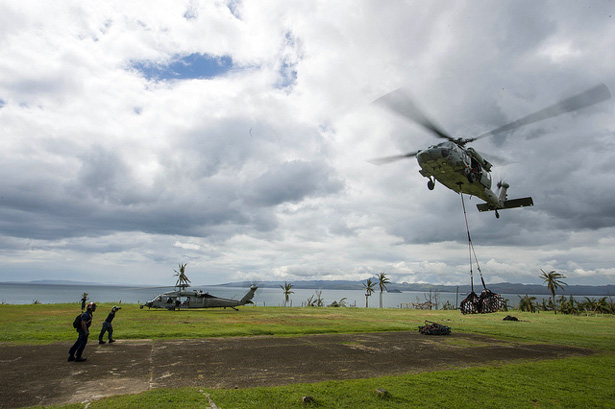-
Climate Change and National Security in an Age of Austerity: The 2014 Quadrennial Defense Review
March 7, 2014 By Kate Diamond
Earlier this week, the Department of Defense released its first Quadrennial Defense Review since fiscal cliffs, shutdowns, and spending cuts hit the federal government. Not surprisingly, “austerity” shows up in almost every chapter of the report. What shows up even more? Climate change. For the second QDR in a row, the Pentagon has called out climate change as a “significant challenge for the United States and the world at large.”
The 2014 QDR uses the military’s now-standard “threat multiplier” language, saying the effects of climate change “will aggravate stressors abroad such as poverty, environmental degradation, political instability, and social tensions – conditions that can enable terrorist activity and other forms of violence.”
But there’s also some fairly unequivocal language about how the DOD sees these threats playing out:
As greenhouse gas emissions increase, sea levels are rising, average global temperatures are increasing, and severe weather patterns are accelerating. These changes, coupled with other global dynamics, including growing, urbanizing, more affluent populations, and substantial economic growth in India, China, Brazil, and other nations, will devastate homes, land, and infrastructure.
Changes wrought by a changing climate may also bring new opportunities for cooperation and peacebuilding.There are fears that competition over scarce natural resources may provoke new conflicts while more frequent humanitarian disasters strain the military’s ability to quickly respond to crises (which, from Haiti to Japan and the Philippines, has proved indispensable). At the same time, the DOD anticipates climate change will undermine its operational readiness at training facilities and bases. To counteract that risk, the QDR promises to assess all military installations for vulnerabilities to climate change and to develop plans to boost resilience in the face of uncertainty. Those preventative plans will be all the more important in an age of austerity.
But the changes wrought by a changing climate may also bring new opportunities for cooperation and peacebuilding. The QDR notes that climate change “creates both a need and an opportunity for nations to work together.” A more-accessible Arctic, humanitarian assistance operations, and disaster response are just a few examples where the military sees more international cooperation in the coming years.
With the QDR in mind, we’ve gone through our archives to put together a reading list for those of you looking for a closer look at how climate change affects not only the U.S. military but security and stability across the board:
Why Do Climate Changes Lead to Conflict? Provocative New Study Leaves Questions: It’s often taken for granted that climate change will lead to more violent conflict, but researchers are still torn on this question. What makes societies vulnerable to climate change? Why? And is it something that can be predicted?
Do High Food Prices Cause Social Unrest? Likewise, food prices have been cited as the drivers for global unrest, from the Arab Spring to Venezuela. But what matters more – variability or sustained high prices? Marc F. Bellemare explains that traditional understandings of how food prices impact stability may be wrong.
Spring Thaw: What Role Did Climate Change and Natural Resource Scarcity Play in the Arab Spring? In the aftermath of the Arab Spring, several high-profile reports suggested that climate change and natural resource scarcity contributed to the events that have rocked the Middle East and North Africa since December 2010. But what exactly was the role of environmental factors in the mass movement?
Harvesting Peace: Food Security, Conflict, and Cooperation: The links between violent conflict and food security are equally complex. Emmy Simmons, lead author of ECSP Report 14: Harvesting Peace draws insights from the latest research to help inform more effective programming for development practitioners.
Band of Conflict: What Role Do Demographics, Climate Change, and Natural Resources Play in the Sahel? When Mali’s government was overthrown in 2012 and nearly overrun by rebels in 2013, West Africa lost one of its hitherto-most stable democracies. Chronic challenges – including demographics, climate change, and natural resource inequities – lay beneath the conflict, and stretch across much of the Sahel.
Backdraft: Flipping the Frame on Conflict and Climate Change: What if efforts to address climate change create more conflict in the process? In ECSP Report 14: Backdraft, authors from around the world outline why it’s imperative to carefully consider the effects of climate adaptation efforts on existing tensions.
Linking Oil and War: Review of ‘Petro-Aggression’: In Petro-Aggression: When Oil Causes War former Wilson Center Fellow Jeff Colgan explores the relationship between oil wealth, regime type, and interstate war, finding certain petro-states have a propensity towards conflict.
Planning for Complex Risks: Environmental Change, Energy Security, and the Minerva Initiative: Chad M. Briggs, former head of the U.S. Air Force Minerva Program, discusses the two-year endeavor to assess energy and environmental security risks and their potential implications for U.S. military strategy and operations.
National Intelligence Council Releases ‘Global Trends 2030’: Prominent Roles Predicted for Demographic and Environmental Trends: The latest edition of the National Intelligence Council’s quadrennial Global Trends report predicts environmental and demographic change will be two of four “megatrends” shaping international relations over the next 20 years.
DOD’s Daniel Chiu: Climate, Energy Concerns Emblematic of Future Security Challenges: U.S. Deputy Assistant Secretary of Defense for Strategy Daniel Chiu explains how the Pentagon has come to incorporate climate change and energy security into its strategic planning.
Sources: U.S. Department of Defense.
Photo Credit: A U.S. Navy helicopter delivers supplies in the Philippines, courtesy of Mackenzie P. Adams/U.S. Navy.
 A Publication of the Stimson Center.
A Publication of the Stimson Center.



